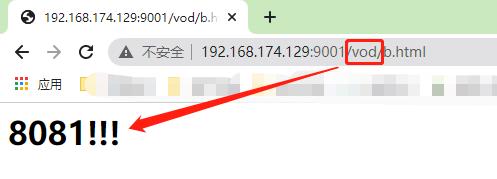Linux ❀ Nginx反向代理配置参数详解
Posted 国家级干饭型选手°
tags:
篇首语:本文由小常识网(cha138.com)小编为大家整理,主要介绍了Linux ❀ Nginx反向代理配置参数详解相关的知识,希望对你有一定的参考价值。
1、修改访问端口为自定义端口
需要预先准备一台目标网页服务,此处选择为Tomcat服务,服务器IP地址为10.81.20.165,端口选择为默认端口8080;
配置nginx配置文件:
[root@localhost ~]# cat /etc/nginx/nginx.conf
server {
listen 8001 default_server;
listen [::]:8001 default_server;
#修改侦听端口为自定义端口;
server_name 10.81.20.167;
#修改服务名称为服务器对应IP地址;
root /usr/share/nginx/html;
# Load configuration files for the default server block.
include /etc/nginx/default.d/*.conf;
location / {
proxy_pass http://10.81.20.165:8080;
#配置代理目标为10.81.20.165的8080端口,此处为Tomcat;
}
修改本地主机hosts文件或者DNS使得域名可达,即可访问到目标网页;
本地hosts配置内容:10.81.20.167 www.aaa.com

2、针对访问URI跳转到不同的访问端口页面
准备两个Tomcat服务,端口分别为8080与8081(端口可以自定义设置,不冲突即可);
[root@localhost ~]# mkdir /tmp/tomcat({8080,8081}
[root@localhost ~]# cp /root/apache-tomcat-9.0.54.tar.gz /tmp/tomcat8080/apache-tomcat-9.0.54.tar.gz
[root@localhost ~]# cp /root/apache-tomcat-9.0.54.tar.gz /tmp/tomcat8081/apache-tomcat-9.0.54.tar.gz
部署第一台Tomcat服务8080端口;
[root@localhost ~]# ll /tmp/ | grep tomcat
drwxr-xr-x. 3 root root 69 Oct 12 20:23 tomcat8080
drwxr-xr-x. 3 root root 69 Oct 12 20:20 tomcat8081
[root@localhost ~]# cd /tmp/tomcat8080/
[root@localhost tomcat8080]# tar -xvf apache-tomcat-9.0.54.tar.gz
[root@localhost tomcat8080]# cd apache-tomcat-9.0.54/bin/
[root@localhost bin]# sh startup.sh
Using CATALINA_BASE: /tmp/tomcat8080/apache-tomcat-9.0.54
Using CATALINA_HOME: /tmp/tomcat8080/apache-tomcat-9.0.54
Using CATALINA_TMPDIR: /tmp/tomcat8080/apache-tomcat-9.0.54/temp
Using JRE_HOME: /usr
Using CLASSPATH: /tmp/tomcat8080/apache-tomcat-9.0.54/bin/bootstrap.jar:/tmp/tomcat8080/apache-tomcat-9.0.54/bin/tomcat-juli.jar
Using CATALINA_OPTS:
Tomcat started.
部署第二台Tomcat服务8081端口;
[root@localhost bin]# cd ../../../tomcat8081/
[root@localhost tomcat8081]# tar -xvf apache-tomcat-9.0.54.tar.gz
[root@localhost tomcat8081]# cd apache-tomcat-9.0.54/conf/
[root@localhost conf]# vim server.xml
<?xml version="1.0" encoding="UTF-8"?>
<!--
Licensed to the Apache Software Foundation (ASF) under one or more
contributor license agreements. See the NOTICE file distributed with
this work for additional information regarding copyright ownership.
The ASF licenses this file to You under the Apache License, Version 2.0
(the "License"); you may not use this file except in compliance with
the License. You may obtain a copy of the License at
http://www.apache.org/licenses/LICENSE-2.0
Unless required by applicable law or agreed to in writing, software
distributed under the License is distributed on an "AS IS" BASIS,
WITHOUT WARRANTIES OR CONDITIONS OF ANY KIND, either express or implied.
See the License for the specific language governing permissions and
limitations under the License.
-->
<!-- Note: A "Server" is not itself a "Container", so you may not
define subcomponents such as "Valves" at this level.
Documentation at /docs/config/server.html
-->
<Server port="8015" shutdown="SHUTDOWN">
#修改服务端口(自行设置,默认为8005),不能端口冲突;
<Listener className="org.apache.catalina.startup.VersionLoggerListener" />
<!-- Security listener. Documentation at /docs/config/listeners.html
<Listener className="org.apache.catalina.security.SecurityListener" />
-->
<!-- APR library loader. Documentation at /docs/apr.html -->
<Listener className="org.apache.catalina.core.AprLifecycleListener" SSLEngine="on" />
<!-- Prevent memory leaks due to use of particular java/javax APIs-->
<Listener className="org.apache.catalina.core.JreMemoryLeakPreventionListener" />
<Listener className="org.apache.catalina.mbeans.GlobalResourcesLifecycleListener" />
<Listener className="org.apache.catalina.core.ThreadLocalLeakPreventionListener" />
<!-- Global JNDI resources
Documentation at /docs/jndi-resources-howto.html
-->
<GlobalNamingResources>
<!-- Editable user database that can also be used by
UserDatabaseRealm to authenticate users
-->
<Resource name="UserDatabase" auth="Container"
type="org.apache.catalina.UserDatabase"
description="User database that can be updated and saved"
factory="org.apache.catalina.users.MemoryUserDatabaseFactory"
pathname="conf/tomcat-users.xml" />
</GlobalNamingResources>
<!-- A "Service" is a collection of one or more "Connectors" that share
a single "Container" Note: A "Service" is not itself a "Container",
so you may not define subcomponents such as "Valves" at this level.
Documentation at /docs/config/service.html
-->
<Service name="Catalina">
<!--The connectors can use a shared executor, you can define one or more named thread pools-->
<!--
<Executor name="tomcatThreadPool" namePrefix="catalina-exec-"
maxThreads="150" minSpareThreads="4"/>
-->
<!-- A "Connector" represents an endpoint by which requests are received
and responses are returned. Documentation at :
Java HTTP Connector: /docs/config/http.html
Java AJP Connector: /docs/config/ajp.html
APR (HTTP/AJP) Connector: /docs/apr.html
Define a non-SSL/TLS HTTP/1.1 Connector on port 8080
-->
<Connector port="8081" protocol="HTTP/1.1"
#修改链接端口,默认为8080;
connectionTimeout="20000"
redirectPort="8444" />
<!-- A "Connector" using the shared thread pool-->
<!--
<Connector executor="tomcatThreadPool"
port="8080" protocol="HTTP/1.1"
connectionTimeout="20000"
redirectPort="8443" />
-->
<!-- Define an SSL/TLS HTTP/1.1 Connector on port 8443
This connector uses the NIO implementation. The default
SSLImplementation will depend on the presence of the APR/native
library and the useOpenSSL attribute of the
AprLifecycleListener.
Either JSSE or OpenSSL style configuration may be used regardless of
the SSLImplementation selected. JSSE style configuration is used below.
-->
<!--
<Connector port="8443" protocol="org.apache.coyote.http11.Http11NioProtocol"
maxThreads="150" SSLEnabled="true">
<SSLHostConfig>
<Certificate certificateKeystoreFile="conf/localhost-rsa.jks"
type="RSA" />
</SSLHostConfig>
</Connector>
-->
<!-- Define an SSL/TLS HTTP/1.1 Connector on port 8443 with HTTP/2
This connector uses the APR/native implementation which always uses
OpenSSL for TLS.
Either JSSE or OpenSSL style configuration may be used. OpenSSL style
configuration is used below.
-->
<!--
<Connector port="8443" protocol="org.apache.coyote.http11.Http11AprProtocol"
maxThreads="150" SSLEnabled="true" >
<UpgradeProtocol className="org.apache.coyote.http2.Http2Protocol" />
<SSLHostConfig>
<Certificate certificateKeyFile="conf/localhost-rsa-key.pem"
certificateFile="conf/localhost-rsa-cert.pem"
certificateChainFile="conf/localhost-rsa-chain.pem"
type="RSA" />
</SSLHostConfig>
</Connector>
-->
<!-- Define an AJP 1.3 Connector on port 8009 -->
<!--
<Connector protocol="AJP/1.3"
address="::1"
port="8009"
redirectPort="8443" />
-->
<!-- An Engine represents the entry point (within Catalina) that processes
every request. The Engine implementation for Tomcat stand alone
analyzes the HTTP headers included with the request, and passes them
on to the appropriate Host (virtual host).
Documentation at /docs/config/engine.html -->
<!-- You should set jvmRoute to support load-balancing via AJP ie :
<Engine name="Catalina" defaultHost="localhost" jvmRoute="jvm1">
-->
<Engine name="Catalina" defaultHost="localhost">
<!--For clustering, please take a look at documentation at:
/docs/cluster-howto.html (simple how to)
/docs/config/cluster.html (reference documentation) -->
<!--
<Cluster className="org.apache.catalina.ha.tcp.SimpleTcpCluster"/>
-->
<!-- Use the LockOutRealm to prevent attempts to guess user passwords
via a brute-force attack -->
<Realm className="org.apache.catalina.realm.LockOutRealm">
<!-- This Realm uses the UserDatabase configured in the global JNDI
resources under the key "UserDatabase". Any edits
that are performed against this UserDatabase are immediately
available for use by the Realm. -->
<Realm className="org.apache.catalina.realm.UserDatabaseRealm"
resourceName="UserDatabase"/>
</Realm>
<Host name="localhost" appBase="webapps"
unpackWARs="true" autoDeploy="true">
<!-- SingleSignOn valve, share authentication between web applications
Documentation at: /docs/config/valve.html -->
<!--
<Valve className="org.apache.catalina.authenticator.SingleSignOn" />
-->
<!-- Access log processes all example.
Documentation at: /docs/config/valve.html
Note: The pattern used is equivalent to using pattern="common" -->
<Valve className="org.apache.catalina.valves.AccessLogValve" directory="logs"
prefix="localhost_access_log" suffix=".txt"
pattern="%h %l %u %t "%r" %s %b" />
</Host>
</Engine>
</Service>
</Server>
[root@localhost conf]# cd ../bin/
[root@localhost bin]# sh startup.sh
创建两个不同端口服务访问目标特征参数;
[root@localhost ~]# cd /tmp/tomcat8080/apache-tomcat-9.0.54/webapps/
[root@localhost webapps]# mkdir edu
[root@localhost webapps]# cd edu/
[root@localhost edu]# cat a.html
<h1>8080!!!</h1>
使用浏览器测试访问;

[root@localhost ~]# cd /tmp/tomcat8081/apache-tomcat-9.0.54/webapps/
[root@localhost webapps]# mkdir vod
[root@localhost webapps]# cd vod/
[root@localhost vod]# cat b.html
<h1>8081!!!</h1>
使用浏览器测试访问;

配置Nginx配置文件;
[root@localhost ~]# cat /etc/nginx/nginx.conf
~
server {
listen 9001 default_server;
#侦听端口为9001;
server_name 192.168.174.129;
location ~ /edu/ {
#访问路径包含edu则跳转到本地8080端口;
proxy_pass http://127.0.0.1:8080;
}
location ~ /vod/ {
#访问路径包含vod则跳转到本地8081端口;
proxy_pass http://127.0.0.1:8081;
}
}
~
#配置文件修改,需要重启服务;
[root@localhost ~]# systemctl restart nginx
使用浏览器验证反向代理是否成功;


以上是关于Linux ❀ Nginx反向代理配置参数详解的主要内容,如果未能解决你的问题,请参考以下文章